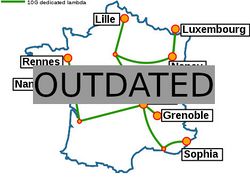Grid5000:Home: Difference between revisions
No edit summary |
No edit summary |
||
| Line 7: | Line 7: | ||
Key features: | Key features: | ||
* provides '''access to a large amount of resources''': | * provides '''access to a large amount of resources''': 12000 cores, 800 compute-nodes grouped in homogeneous clusters, and featuring various technologies: GPU, SSD, NVMe, 10G Ethernet, Infiniband, Omnipath | ||
* '''highly reconfigurable and controllable''': researchers can experiment with a fully customized software stack thanks to bare-metal deployment features, and can isolate their experiment at the networking layer | * '''highly reconfigurable and controllable''': researchers can experiment with a fully customized software stack thanks to bare-metal deployment features, and can isolate their experiment at the networking layer | ||
* '''advanced monitoring and measurement features for traces collection of networking and power consumption''', providing a deep understanding of experiments | * '''advanced monitoring and measurement features for traces collection of networking and power consumption''', providing a deep understanding of experiments | ||
Revision as of 08:23, 18 September 2018
|
Grid'5000 is a large-scale and versatile testbed for experiment-driven research in all areas of computer science, with a focus on parallel and distributed computing including Cloud, HPC and Big Data. Key features:
Older documents:
|
Random pick of publications
Five random publications that benefited from Grid'5000 (at least 2928 overall):
- Jérôme Rouzé, Nouredine Melab, Daniel Tuyttens. A Parallel Genetic Algorithm for Qubit Mapping on Noisy Intermediate-Scale Quantum Machines. International Conference in Optimization and Learning - OLA 2024, May 2024, Dubrovnik, Croatia. hal-04916922 view on HAL pdf
- Imran Ahamad Sheikh, Emmanuel Vincent, Irina Illina. Training RNN Language Models on Uncertain ASR Hypotheses in Limited Data Scenarios. Computer Speech and Language, 2024, 83, pp.101555. 10.1016/j.csl.2023.101555. hal-03327306v2 view on HAL pdf
- Diego Amaya-Ramirez. Data science approach for the exploration of HLA antigenicity based on 3D structures and molecular dynamics. Bioinformatics q-bio.QM. Université de Lorraine, 2024. English. NNT : 2024LORR0071. tel-04708399 view on HAL pdf
- G. Briffoteaux, N. Melab, Mohand Mezmaz, D. Tuyttens. Investigating surrogate-based hybrid acquisition processes. Application to Covid-19 contact mitigation. Applied Soft Computing, 2024, 151, pp.111134. 10.1016/j.asoc.2023.111134. hal-04383812 view on HAL pdf
- Chih-Kai Huang, Guillaume Pierre. UnBound: Multi-Tenancy Management in Scalable Fog Meta-Federations. UCC 2024 - 17th IEEE/ACM International Conference on Utility and Cloud Computing, Dec 2024, Sharjah, United Arab Emirates. pp.1-11. hal-04760398 view on HAL pdf
Latest news
Failed to load RSS feed from https://www.grid5000.fr/mediawiki/index.php?title=News&action=feed&feed=atom: Error parsing XML for RSS
Grid'5000 sites
Current funding
As from June 2008, Inria is the main contributor to Grid'5000 funding.
INRIA |
CNRS |
UniversitiesUniversité Grenoble Alpes, Grenoble INP |
Regional councilsAquitaine |


